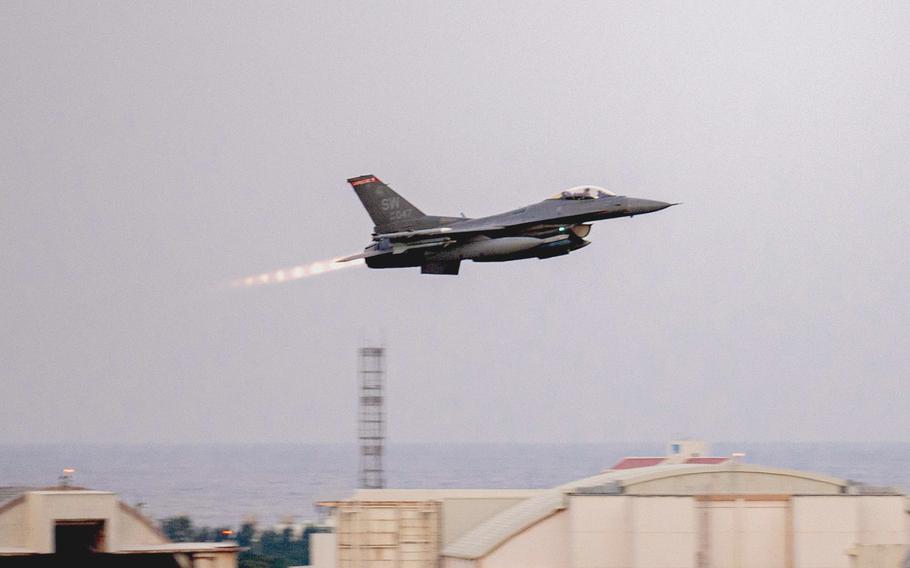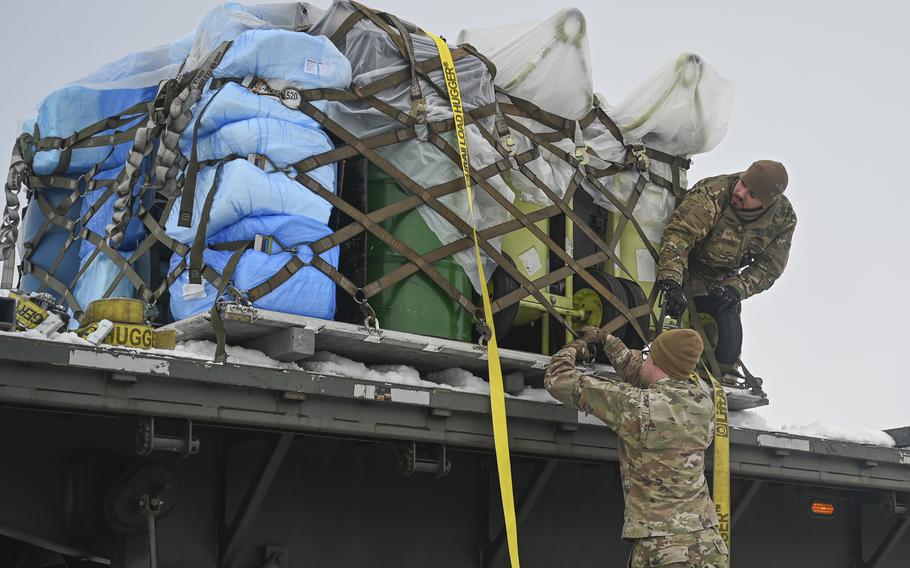
An Air Force F-16C Fighting Falcon with the 77th Expeditionary Fighter Squadron takes off at Kadena Air Base, Japan, on Jan. 13, 2025. (Catherine Daniel/U.S. Army)
Air Force wings in Japan and South Korea dispersed aircraft and airmen during weeklong rehearsals this month for flying and fighting on the move.
Airmen from the 8th Fighter Wing at Kunsan Air Base, South Korea, executed their first agile combat employment drill during Exercise Beverly Pack 25-1, Jan. 12-16 at Gwangju Air Base.
On Okinawa, the 18th Wing at Kadena Air Base conducted a similar rapid response exercise, Beverly High 25-1, Jan. 8-15. A fighter squadron deployed to a mainland base to test its ability to fly and fight under less-than-ideal conditions, part of the Air Force’s agile combat employment doctrine, or ACE.
The doctrine is designed to frustrate enemy targeting and create operational dilemmas by scattering assets to distant airfields, among other tactics.
The 8th Fighter Wing deployed airmen to a simulated forward operating base at Gwangju, according to a wing news release. The exercise demonstrated units’ ability to disperse swiftly in response to potential threats.
“We are exercising our dispersal capabilities by taking a small detachment from our main operating base and moving them here for a short period of time to execute contingency [operations],” 1st Lt. Charles Burns, the ACE detachment director of operations, said in the release.
During the exercise, the 8th Maintenance Group conducted the wing’s first integrated combat turn, which involved rearming an F-16 Fighting Falcon with an air-to-surface standoff missile while the jet’s engines were running.
The maneuver allows a quick turnaround during combat operations, putting aircraft back into the flight, wing spokesman Capt. Alvin Nelson told Stars and Stripes by email Friday.
Beverly Pack put airmen into mock combat under austere conditions, according to the release. Nelson said the Gwangju challenges were created by design.
Airmen operated with a leaner footprint, less equipment and personnel to generate airpower while responding to simulated threats, he said.

Senior Airman Austin Payton, left, and Staff Sgt. William Rios-Cruz, unstrap cargo from a vehicle during Beverly Pack 25-1 at Kunsan Air Base, South Korea, Jan. 12, 2025. (Maria Umanzor Guzman/U.S. Air Force)
“This has led us into a larger package of mission generation capability — we are able to fix aircraft more in depth based off the things and people we brought with us here,” Senior Master Sgt. Shelley Schofield, the detachment’s senior enlisted leader, said in the release.
At Kadena, the 77th Expeditionary Fighter Squadron deployed F-16C Fighting Falcons to Marine Corps Air Station Futenma, Japan, “to simulate generating combat airpower from a dispersed location,” according to a Jan. 16 news release from the 18th Wing.
The wing enhanced its warfighting capabilities, improved its ability to flex and adapt to changing situations, and strengthened its overall operational readiness by practicing agile combat employment concepts, wing spokesman Maj. Alli Stormer told Stars and Stripes by email Monday.
This type of exercise reinforces the wing’s readiness to respond effectively to any contingency or operational demand, she said.
“Participating in this ACE deployment to MCAS Futenma provided us an opportunity to test our communications equipment and hone our ability to generate aircraft alongside our USMC partners,” Air Force Lt. Col. Steven McCord, the 77th squadron’s director of operations, said in the release.
“Each time we exercise ACE, we’re able to move faster and leaner than before, providing us with the tactics we need to succeed,” he said.